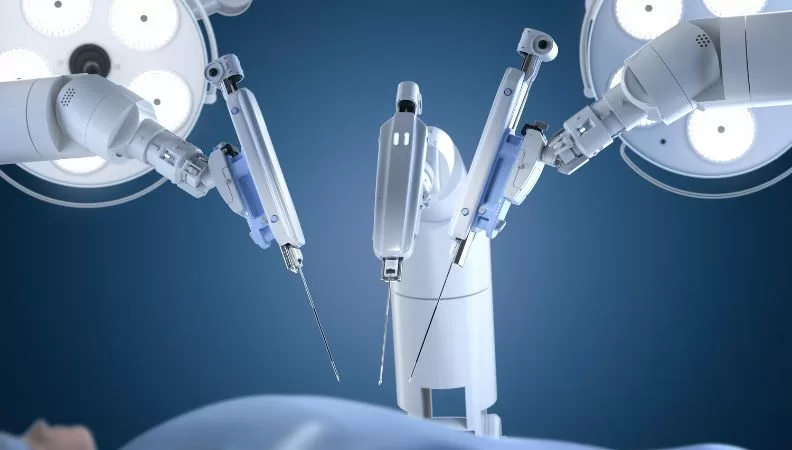The Role of Robotics in Surgery: Enhancing Precision and Efficiency
In recent years, robotic surgery has become a groundbreaking force in the medical field, dramatically transforming how surgical procedures are performed. As technology advances, robot-assisted surgery is enhancing precision, reducing human error, and improving overall efficiency in the operating room. This has led to smaller incisions, faster recovery times, and better patient outcomes. The integration of robotic-assisted procedures with artificial intelligence (AI) and real-time data analysis is ushering in a new era of healthcare—one defined by precision and efficiency.
History of Robotics in Surgery: Advancements and Milestones
The idea of robotics in surgery is not a new development. The history of robotic surgery goes back to the 1980s. It was then that the first robotic surgical system, PUMA 560, was established. This was specifically aimed at assisting neurosurgeons in biopsy procedures. Over time, such evolution took place with the da Vinci Surgical System, improving dexterity and 3D visualization. This was the point of great change in medical technology, and it opened up the doors for minimally invasive procedures and enhanced surgical outcomes, from traditional surgery to robotic-assisted techniques.
How Robotic Surgery Functions: Process and Technology Explained
The use of a robotic system by a surgeon controls complex procedures with increased precision. The robotic system includes the following: arms, a high-definition 3D camera, and specialized instruments. The surgeon sits at a console and can maneuver the robotic arms and instruments directly. Advanced imaging technologies make available real-time information for highly detailed observations of the surgical site. Artificial intelligence is integrated into these systems to enhance decision-making and surgical precision, giving surgeons a powerful, yet intuitive interface.
Advantages of Robotic Surgery: Benefits and Impact
The advantages of robotic surgery abound. Perhaps the greatest benefit is that it offers a more precise and accurate outcome, thereby minimizing the chance of human error during sensitive procedures. With smaller incisions, robotic surgeries are generally minimally invasive, resulting in less blood loss and quicker recovery times. Moreover, patients tend to feel less pain and scarring, which makes robotic-assisted surgery very appealing. The reduced risk of complications, such as infections, is another key benefit, contributing to better patient outcomes overall.
Key Technologies Driving Robotic Surgery Advancements
Central to the success of robotic surgery are the technologies that drive these systems. Robotic arms, designed for maximum dexterity, allow for highly intricate movements that are difficult to achieve with human hands alone. Surgeons control these arms through an ergonomic interface, which often includes a console with a 3D visualization system. Artificial intelligence plays an increasingly vital role by providing real-time feedback, enhancing the surgeon’s decision-making process. Additionally, technologies like haptic feedback provide tactile sensations, helping surgeons to feel the tissues they are working with, further improving the precision of their actions.
Types of Robotic Surgery Systems: A Comprehensive Overview
Currently, several robotic surgery systems are being used. Among these, some are quite versatile and can be applied across many specialties, and some are very specialized in the field. One of the most well-known systems is the da Vinci Surgical System. Another is the Mako robotic system, which is commonly used in orthopedic surgery for precise placement of bones in joint replacement. Other specialized systems deal with other specialties, such as urology and gynecology, each providing instruments appropriate to the surgeon’s specific needs. Each of these systems was designed to add more precision and less invasiveness and promote better patient outcomes.
Robotic Surgery Applications in Various Fields
Robotic surgery has developed well in almost all medical specialties, including urology, gynecology, orthopedics, and cardiology. Automated surgical systems enhance precision in urology, allowing for prostate cancer procedures with minimal tissue damage. In gynecology, they offer a less invasive approach for hysterectomy and fibroid removal, leading to better surgical outcomes. Orthopedic surgery also benefits from advanced technology, improving joint replacement accuracy and ensuring optimal placement for better patient results. Robotic surgery in cardiology makes it easy to carry out complicated heart operations with a positive outcome and minimized risk.
Robotics Role in Minimally Invasive Surgery
Minimally invasive surgery associated with robotic surgery procedures. These robotic systems assist surgeons in achieving surgical intervention using minimal cuts which can be up to just a few small incisions rather than opening large cuts for surgery. These smaller entrance wounds minimize damage to the tissue surrounding the areas of surgery; thus, this results in diminished blood loss as well as shortened recovery periods. In addition, patients experience a decrease in the amount of pain post-surgery and complications during recovery. Accuracy through robotics facilitates further benefits related to minimally invasive surgery because it allows doctors to carry out highly complex interventions with minimal danger.
Robotic Surgery: Impact on Patient Outcomes and Results
The discovery of robotic surgery has greatly transformed patient results. Robotic surgery has reduced recovery times, pain experienced by the patient, and complications by enhancing the precision of surgeons along with a reduction in the invasiveness of treatments. Researchers often mention that, for instance, robotic-assisted prostatectomy has fewer effects such as incontinence and erectile dysfunction as compared to traditional treatments.
This reduces the incidence of postoperative complications and consequently leads to good long-term health outcomes for the patients.
Overcoming Challenges in Robotic Surgery: Solutions and Strategies
Robotic surgery is not devoid of challenges, despite its various advantages. One of the greatest barriers to wide-scale adoption remains the high costs of initial setups of robotic systems, especially in resource-limited settings. Moreover, the cost of the maintenance of disposable instruments is always present and running. A problem in itself is the required specific training on surgeons’ skills for proper operating complex systems. Surgeons will masterfully demand thorough training in robotic techniques, which are time-consuming and expensive. Lastly, the technology’s limitations include its reliance on electrical current and its susceptibility to system breakdown.
The Future of Robotic Surgery: Evolving Technologies and Trends
Robotic surgery is the future and advances are promising it to be very precise in the future and most efficient in precision with the advent of artificial intelligence and machine learning in these robotic systems that will make it possible for a robot to treat patients by being able to look at patient data in real-time, optimize the surgical approach and minimize human error. In addition, future advancements in robotic miniaturization will drive more accessible and flexible surgical robots. The continued evolution of telemedicine will influence the future of robotic surgery, enabling surgeons to perform remote surgeries with unprecedented precision.
Robotic Surgery: Enhancing Cost Efficiency in Healthcare
These advanced surgical systems have high up-front costs but can save significant money over time. They enhance accuracy, reducing complications, hospitalizations, and recovery time. They also use fewer resources than open surgeries, improving efficiency and lowering healthcare costs.
Ethical Considerations in Robotic Surgery
The rise of automated surgical procedures brings important ethical considerations. One concern is how much we should involve automation in patient care, particularly when machines perform complex procedures.
While advanced systems enhance precision, there is a question of whether they can replace human judgment in critical situations. More importantly, the increasing popularity of these technologies raises concerns about equity in access. Such advanced procedures may not reach equal percentages of patients in underserved areas.
The Future Role of Robotics in Remote Surgery
It is also enabling remote surgery in which surgeons perform procedures miles away from the patients.
Tele-surgery is now a reality, with robotic systems that allow surgeons in distant locations to control instruments in real-time. This technology has the potential to revolutionize access to specialized care, especially in rural or underserved areas. This means that surgeons can carry out remote surgeries with the same precision and efficiency as they conduct surgeries in an operating room. This way, patients in remote locations can get the benefit of top-tier surgeons.
Conclusion
The role of robotics in surgery is revolutionizing healthcare to provide more accuracy, efficiency, and better results for patients. With advancing technology, robotic systems will become an even more integral part of the surgical process, enabling more complex procedures with fewer risks. Despite the challenges, the future of robotic surgery looks promising, with advancements in AI, remote surgery, and cost-efficiency poised to make these technologies more accessible and effective. Robotics is not just enhancing surgery; it is revolutionizing the very nature of patient care.
For more information about this (Robotic Surgery) visit our website or



